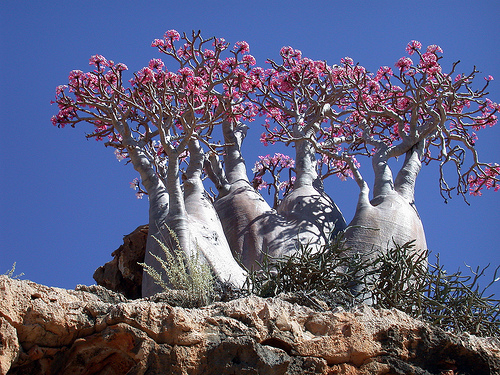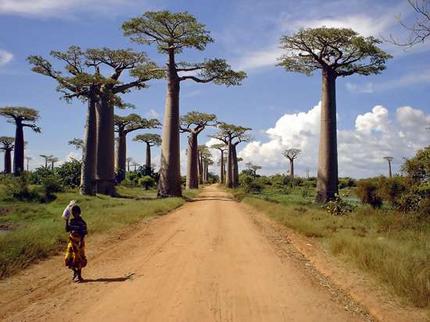We all have dream destinations. I have been to a few of mine already, but there are far more on my list that I haven’t yet visited. I am a big fan of nature and historic structures. And, of course, the unique and interesting is hard to beat. While I would love to visit Antarctica, Borobudur (Indonesia), the Pyramids, the Dead Sea, and many other places, the following destinations are at the very top of my list.
Socotra, Yemen
 Socotra is a small island off the Arabian Peninsula that is covered in unique and spectacular plants. Nearly 40% of the plant species are endemic to the island, making it the Galapagos of the Indian Ocean. The Dragon’s Blood Tree is probably the most notable plant on the island. In the past there were giant land turtles and crocodiles, but they are no more. Unfortunately, Socotra is not located in the most friendly of places in the world for Americans, never mind the fact that it is relatively isolated. One day, I hope soon, I will have the opportunity to visit.
Socotra is a small island off the Arabian Peninsula that is covered in unique and spectacular plants. Nearly 40% of the plant species are endemic to the island, making it the Galapagos of the Indian Ocean. The Dragon’s Blood Tree is probably the most notable plant on the island. In the past there were giant land turtles and crocodiles, but they are no more. Unfortunately, Socotra is not located in the most friendly of places in the world for Americans, never mind the fact that it is relatively isolated. One day, I hope soon, I will have the opportunity to visit.
Madagascar
 Off the Eastern coast of Africa, Madagascar is probably most famous for its lemurs. The island’s long isolation from the mainland has resulted in some really interesting flora and fauna, beyond just lemurs. 90% of the native plants are found nowhere else. Unfortunately, many of the plants and animals are in danger of extinction. The Elephant Bird (a 10 feet tall bird) went extinct in the 17th century, and lemurs are not far behind. I hope to have the chance to see what is left before habitat destruction takes it toll.
Off the Eastern coast of Africa, Madagascar is probably most famous for its lemurs. The island’s long isolation from the mainland has resulted in some really interesting flora and fauna, beyond just lemurs. 90% of the native plants are found nowhere else. Unfortunately, many of the plants and animals are in danger of extinction. The Elephant Bird (a 10 feet tall bird) went extinct in the 17th century, and lemurs are not far behind. I hope to have the chance to see what is left before habitat destruction takes it toll.
Petra, Jordan
 Made famous by Indian Jones, Petra is a real city that was carved out of stone—truly amazing. The Nabataeans had a flourishing society in the middle of the desert on a main trade route. Intricate systems of channeling water into the city meant they had a precious commodity that made them in hot spot for caravans to stop. Of course, the Nabataeans extracted a fee for traveling through. Roman rule and changing trade routes caused Petra to rapidly decline. Erosion, poor restoration of the structures, and unsustainable tourism are the current threats to Petra today.
Made famous by Indian Jones, Petra is a real city that was carved out of stone—truly amazing. The Nabataeans had a flourishing society in the middle of the desert on a main trade route. Intricate systems of channeling water into the city meant they had a precious commodity that made them in hot spot for caravans to stop. Of course, the Nabataeans extracted a fee for traveling through. Roman rule and changing trade routes caused Petra to rapidly decline. Erosion, poor restoration of the structures, and unsustainable tourism are the current threats to Petra today.
Easter Island (Rapa Nui)
 Giant eyeless Moai, with their backs facing the ocean, peer across an island that is no longer covered with palm trees. Deforestation caused by climate change may have contributed to the decline of Easter Island, though more likely it was due to the inhabitants cutting down the trees. If anything, climate change exacerbated the problem, and the resulting soil erosion decimated the small island. Easter Island still has a unique ecosystem and much to see for one of the world’s most isolated island.
Giant eyeless Moai, with their backs facing the ocean, peer across an island that is no longer covered with palm trees. Deforestation caused by climate change may have contributed to the decline of Easter Island, though more likely it was due to the inhabitants cutting down the trees. If anything, climate change exacerbated the problem, and the resulting soil erosion decimated the small island. Easter Island still has a unique ecosystem and much to see for one of the world’s most isolated island.
Machu Picchu, Peru
 The name means “Old Mountain.” The Inca built around 1400AD and the Spanish had no idea it existed while they were busy with their conquest, making it a rather significant find for archaeologists. The wheel was no used in a practical sense by the Inca (they had no beasts of burden and the terrain was not suitable anyway) even though they knew of the concept, making Machu Picchu that much more interesting. The growing numbers of tourists have had an impact and there is currently a debate on how to deal with it.
The name means “Old Mountain.” The Inca built around 1400AD and the Spanish had no idea it existed while they were busy with their conquest, making it a rather significant find for archaeologists. The wheel was no used in a practical sense by the Inca (they had no beasts of burden and the terrain was not suitable anyway) even though they knew of the concept, making Machu Picchu that much more interesting. The growing numbers of tourists have had an impact and there is currently a debate on how to deal with it.
What is at the top of you travel list?